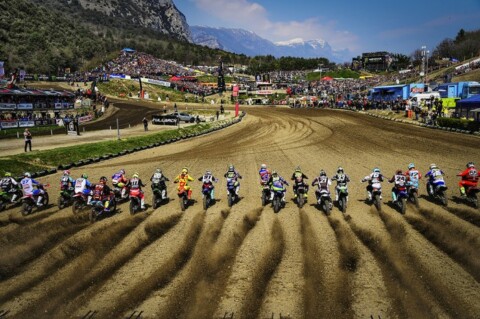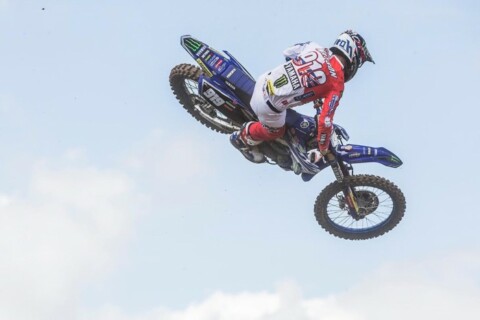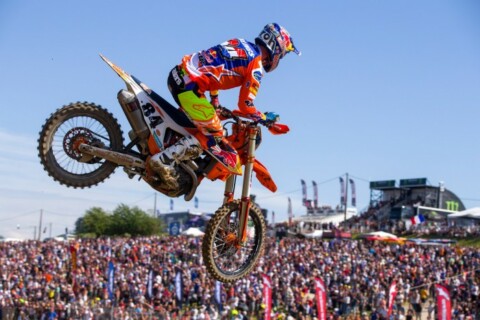Honda has launched its 2018 CRF250R with a DOHC engine featuring a nine per cent power increase over the outgoing model, a higher rev-limit, and it also shares the 450’s mass-centralised frame and 49mm Showa forks.
The top lines are these:
It features a kW/Kg improvement of five per cent. In a wheel-to-wheel test the new CRF250R is three per cent faster from 0-10m and 3.6 per cent quicker over 30m. That’s close to half a bike length, and a full bike length respectively.
Its DOHC engine, with over-square bore and stroke, bigger valves and revised inlet/exhaust setup makes a hefty nine per cent more power up top, for far longer, with extended over-rev and higher redline.
The new fully mass-centralised chassis – identical to the current 18YM CRF450R – can put the extra power to effective use, its geometry and lower centre of gravity driving the rear tyre into the ground harder. The new CRF250R also employs the same Showa 49mm steel-sprung front fork as the CRF450R offering familiar (and extensive) levels of adjustability.
Engine
Central to the improved performance – which is all about much higher gas flow, in and out – is a revised bore and stroke of 79 x 50.9mm, with a 4.5mm cylinder offset to reduce friction (as opposed to 76.8 x 53.8mm, 4mm offset). This is a much more ‘over square’ layout, with bigger bore and shorter stroke which allows the use of larger titanium valves: 33mm inlet (which feature a neck shaped to reduce intake resistance) and 26mm exhaust (30.5mm/25mm).
Lift is also increased: 10.5mm inlet and 9.5mm exhaust (9.2mm/8.4mm) and the valve angle is more compact, going from 21.5° to 20.5°. The rocker arms feature Diamond Like Carbon (DLC) coating, a Nano-thin hard film that provides high wear resistance and lubricity; the valve springs themselves are now oval in section. The inlet valves are fed – via PGM-FI with 46mm throttle bore – by symmetrical straight-shot downdraft intakes, which are shorter for improved high rpm snap.
The new engine features twin exhaust ports, each of which has its own exhaust down pipe, with bends that radius gradually to smooth out gas flow. The twin mufflers are sited 24mm inward toward the centre of the machine, to aid mass centralisation.
Compression ratio goes up slightly from 13.8:1 to 13.9:1 but the piston shape is now a Bridged Box design – the first on a Honda MX machine. Its rigidity converts combustion pressure into high output efficiency and, despite the bore increase, the piston carries no extra mass. Four piston jet oil holes (rather than two) reduce friction and ensure optimised cooling.
The new H-Section crankshaft is 350g lighter while maintaining inertial mass, for response and stiffness, and rigidity. To make the engine as physically compact as possible the axis distance between the crank and balancer shaft is reduced by 0.5mm, and 1mm between the crank and primary gears. The cam chain is now on the right, to shorten the distance between the crankshaft and the mass of the Alternating Current Generator (ACG).
Incorporated into the CRF250R’s new engine is an electric starter motor, replacing the kickstarter. Located centrally (the new crankcase layout ensures all inertial masses are closer to the C of G, for improved handling), it drives the one-way clutch and idle gear via a press-fit torque limiter; its Lithium-ion battery is compact and weighs just 0.65kg. Engine weight with the electric starter added is increased by just 1kg.
Chassis
Saving 340g over the previous design the seventh-generation aluminium beam frame features tapered main spars with a carefully tuned balance between rigidity and flexibility, designed to deliver front-end stability plus a direct feel for traction.
Compared to the outgoing CRF250R design the chassis’ geometry markedly differs; wheelbase is 3mm shorter at 1486mm and the distance between the swingarm pivot point and rear axle is 15mm shorter at 573mm. Rake is set at 27.5° with trail of 116mm. The C of G is 1.4mm lower.
The rear subframe is now extruded aluminium (rather than forged) and is 20 per cent lighter, aiding mass centralisation. Seat height is 6mm taller at 957mm, with 5mm more ground clearance at 327mm. Wet weight (without fuel) is 103.3kg, with fuel 108.1kg.
The Showa SFF-TAC-Air front fork of the previous model has been replaced with a 49mm Showa USD coil-spring fork. Debuted on the current CRF450R it’s not an evolution of the older 48mm fork, but a version of the Showa kit fork supplied to MX race teams in the Japanese championship.
The cylinder has a 25mm diameter, the rod 14mm with the compression piston 39mm. As you’d expect from what is effectively full race-spec suspension the fork action is supple, smooth and always in control. It’s also fully adjustable.
With a top mount 39mm lower and located directly on the machine’s centre line the fully adjustable Showa rear shock works the aluminium swingarm – 220g lighter – through Pro-Link.
Wheels and brakes
A 260mm wave-pattern disc delivers effective heat dissipation, power and feel from the two-piston brake caliper working it; a matching 240mm wave-pattern disc and single-piston caliper is at the rear. Lightweight aluminium rims, with directly attached spoke pattern layout reduce unsprung weight; the front is a 21 x 1.6in, the rear a 19 x 1.85in. Fitted as standard equipment are Dunlop’s GEOMAX MX3S tyres, 80/100-21 front and 100/90-19 rear.










